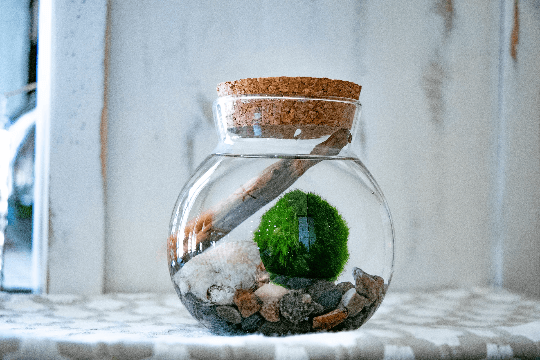Comprehensive Marimo Moss Ball Aquarium Setup Guide for Beginners
Create a living centerpiece inspired by the cool, clear lakes of northern Japan.
Why Choose Marimo?
Marimo (Aegagropila linnaei) are velvety spheres of algae cherished in Japanese folklore as symbols of luck and perseverance. They thrive with minimal care and bring a soothing, sculptural beauty to any space.
Supplies Checklist
-
Marimo Moss Ball Aquarium Starter Kit (glass vessel, river stones, driftwood, Paleozoic fossil, cork lid)
-
Dechlorinated or natural spring water, room temperature
-
Clean work surface and soft microfiber cloth
Step‑by‑Step Marimo Set-up Instructions
-
Prepare the water
Fill a spotless bowl with dechlorinated or spring water. If using tap water, let it sit uncovered for 24 hours or treat it with a water conditioner. This removes chlorine and chloramine that can harm Marimo strands. -
Rinse stones and driftwood
Wash river stones and driftwood under running water to remove dust. Soak the driftwood until it is waterlogged so it will sink instead of float. Clean décor prevents cloudy water and tannin stains. -
Clean the Marimo
Roll the Marimo gently under cool water, then squeeze it lightly to release trapped air. Rolling maintains its round shape and helps it sink promptly. -
Create the foundation
Spread an even bed of river stones on the aquarium floor. A level base keeps décor stable and allows water to circulate freely. -
Arrange driftwood and fossil
Tuck the driftwood and fossil among the stones, creating visual balance from every angle. Natural lines guide the eye and transform the vessel into a miniature landscape. -
Introduce the Marimo
Nestle the sphere gently among the stones so it stays anchored while it acclimates. -
Fill the aquarium
Slowly pour prepared water into the vessel, leaving about half an inch of headspace. A gentle pour protects your layout and prevents sediment clouds. -
Seal the ecosystem
Fit the cork lid snugly. The lid reduces evaporation, keeps dust out, and stabilizes the micro‑climate. -
Polish the glass
Wipe the exterior with a soft cloth so light can reach every emerald strand. -
Choose the perfect spot
Place the aquarium where it receives bright, indirect light such as a north‑facing window or a shaded shelf. Direct sun may overheat the water and trigger nuisance algae, while very low light can stunt growth.
Ongoing Care and Maintenance
-
Rotate the vessel once a week so all sides of the Marimo receive equal light.
-
Change half of the water every two weeks or whenever it looks cloudy.
-
During each change, roll the Marimo gently to preserve its spherical form.
-
Keep temperatures between 65 °F and 77 °F. Avoid heaters or hot windowsills.
For seasonal adjustments, troubleshooting tips, and advanced care, explore our Marimo Moss Ball Care Guide:
Frequently Asked Questions
Can I use tap water straight from the faucet?
Only if you remove chlorine first. Let tap water sit out for 24 hours or treat it with an aquarium‑safe water conditioner before adding it to the tank.
3. Do I have to pre‑soak the driftwood—and for how long?
Yes. Submerge the wood in clean water for at least 12 hours, changing the water once if it turns dark. This saturates the wood so it sinks immediately and releases most of its tannins before you build the landscape.
4. Should the river stones cover the entire bottom?
A single, even layer is ideal. Too many stones trap debris; too few may let the driftwood wobble. Aim for a depth of about ½ inch.
5. Is a cork lid required, or can I leave the top open?
A cork lid helps slow evaporation and keeps dust out, but an open‑top display also works if you top off evaporated water weekly and the tank isn’t in a high‑traffic, dusty area.
6. How do I keep the layout from shifting when I pour in water?
Add water slowly, letting it trickle down the inside wall of the glass or over your hand. This diffuses the flow and prevents stones and fossil pieces from scattering.
7. Does the Marimo need to touch the substrate, or can it float?
Place it gently on the stones so it settles. Contact with the base stabilizes the ball while it acclimates; floating is usually a sign of trapped air.
8. Can I add decorative sand instead of stones?
Coarse sand can work, but fine sand compacts and blocks circulation. Stick with smooth stones or gravel to avoid stagnant pockets.
9. What is the best room temperature for the initial setup?
Set up in a space between 65 °F and 75 °F (18 °C – 24 °C). Extreme cold slows the establishment period, and heat above 80 °F can stress the Marimo before it settles.
10. How soon after setup can I move the aquarium?
Give the layout 24 hours to stabilize and the driftwood to finish releasing bubbles. After that, you can reposition the vessel to its permanent, indirect‑light location.





